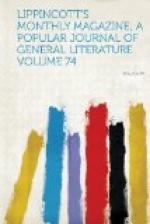This relative debility is, at the same time, more apparent to the stockholders than to their customers. The superstructure and “plant” of the Erie has lately stood interested inspection from abroad with great credit, and that of the Great Western is unexceptionable. The vote of travelers may be safely allotted to the broad gauge. They have more elbow room. The carriages attain the requisite width without unpleasantly, not to say dangerously, overhanging the centre of gravity; and, other things equal, the movement is steadier. Nor is the financial aspect of the question apt to impress gloomily the tourist as he enters the Paddington station and looks around at its blaze of polychrome and richness of decoration generally. As the coach doors are slammed upon you, the guard steps into his “van,” the vast drivers, taller than your head plus the regulation stove-pipe, slowly begin their whirl, and you roll majestically forth through a long file of liveried servants of the company, drawn up or in action on the platform, the sensation of patronizing a poverty-stricken corporation is by no means likely to harass you. You cease to realize that the Napoleon of engineers, Monsieur Brunel, made a disastrous mistake in the design of this splendid highway, and that, as some will have it, it was his Moscow. His error, if one there was, existed only in the selection of the width of track. Whatever the demerits of the design in that one particular, the execution is in all above praise. The road was his pet. Once finished, it was his delight, as with the breeder of a fine horse, to mount it and try its mettle. Over and again would he occupy the footboard between London and Bristol, and rejoice as a strong man in running his race at close to seventy miles an hour. He and Stephenson were capital types of the Gaul and Briton, striving side by side on the same field, as it will be good for the world that they should ever do.
[Illustration: Morton church.]
Combats of another character—in fact, of two other characters—recur to our reflections as we find that we have shuffled off the coil of bricks and mortar and are rattling across Wormwood Scrubs. More fortunate than some who have been there before us, we have no call to alight. Calls to this ancient field of glory, whether symbolized by the gentlemanly pistol or the plebeian fist, have ceased to be in vogue. Dueling and boxing are both frowned down effectually, one by public opinion and the other by the police. It is only of late years that they finally succumbed to those twin discouragers; but it seems altogether improbable that the ordeal by combat in either shape will again come to the surface in a land where tilting-spear and quarter-staff were of old so rife. In France chivalry still asserts, in a feeble way, the privilege of winking and holding out its iron, and refuses to be comforted with a suit for damages.




